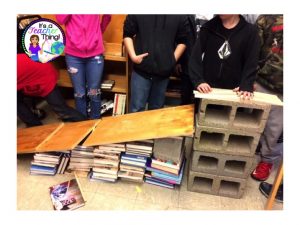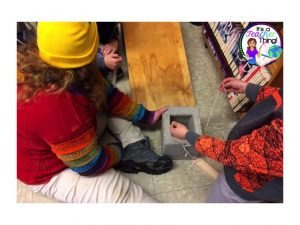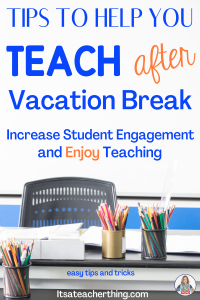Teaching after a vacation break can be tough! Maintaining student motivation is important during any time of year, but it’s even more crucial when they return from a vacation break. Learn my trick for increasing student engagement AFTER a vacation break!
Great ideas for a successful first week back

Engagement and fun are key to teaching after a vacation break
I save several of my “great” activities for those Mondays after a vacation break. This particular Monday morning I pulled out the 10 cinderblocks I store in a cabinet under my sink and counter. I’m always thankful I have these treasures each year at about this time when energy is low, we’re gearing up for test prep mode, and summer seems far, far away.

Use supplies in the classroom to simulate moving pyramid blocks the ancient Egyptian way.
When I pull out the blocks, I know I’ll have instant buy-in.
Here’s why: I’m constantly throwing out teasers to build intrigue for my “Gotcha Activities”. Several times this year, I’ve made it a point to mention that some time soon we’ll attempt to build a pyramid like the ancient Egyptians. And when they stumble in that first Monday after a break, I have a picture of the Great Pyramid up on the screen. I start off by stating some amazing facts about the pyramid.
“It was the tallest building on earth was for more than 3,000 years”
“It took about 25 years to build.”
“No modern technology was used in its construction.”
“People still marvel at its existence, and there’s still debate as to how it was built.”(Need I mention the word…Aliens? Many kids have heard the theories of ET involvement in the pyramids.)
I’m here to tell you—IMMEDIATE ENGAGEMENT! Almost every kid ever to walk through my classroom door has been enthralled by the pyramids of Egypt, so I know I can count on success.
What topics will grab immediate attention when teaching after a vacation break?
Pick your top 5 engaging topics or lessons and plan on purchasing, collecting, and designing a lesson or two with these topics in mind. Keep the activities hands-on if possible, but this isn’t essential.
Increase student motivation when teaching after a vacation break
1. Use interesting facts
Heighten student interest by revealing interesting facts. Have them guess what it is you are going to show or they are going to do. See my statements about the pyramids above. Interesting facts can be the perfect hook to increase student interest. Use them to your advantage and build that motivation.
2. Play a question game
You can hide an object related to your topic in a bag or box and have clues ready to pull out clues one at a time. After each clue, students guess what’s in the bag.
Students can also ask yes/no questions. Each time a question is asked, you can only answer yes or no. This teaches students the difference between larger questions and smaller questions. When I do this, I love having a circle drawn on the projector or board. Each time an important question is answered and students have moved closer to an answer, I shade in a portion of the circle to represent the importance of the answer they just received. When the circle is completely shaded, the answer has been discovered.
3. Add drama into the mix
Come dressed as a character from history or as a character in a novel. Speak as the character for the first few minutes. Have students guess who you are. How does this character you are playing relate to what students are going to learn? When you make this extra effort, students respond. Wear that goofy hat, dress up as an ancient Greek. There are simple, no-cost ways to motivate students during those difficult days of teaching.
4. Save your “Gotcha” lessons for teaching after a vacation break
I’ve also developed a “Gotcha” unit on punctuation that introduces a Killer Panda. Kids love it! It’s a simple lesson on grammar and punctuation, but I play it up so that my students are absolutely enthralled with what it is I’m teaching. Read more about it here, and find this fun unit on punctuation here.
5. Use high-interest science experiments
Keep an engaging science experiment on hand and ready for teaching after a vacation break. Demonstrate a mind-boggling principle in science. Demonstrating changes in pressure is always a high-interest activity with low cost to you. You can find loads of experiments on air pressure here.
6. Start a special unit
5. One engaging activity that’s not hands-on is literature circles. I love to start Literature Circles the day we return from a break. See my blog post here. I have created a unit that includes everything you’ll need to begin literature circles (except the books).

Whatever you use, make sure it keeps the interest level at a premium. Notice that I reveal key information bit by bit during my pyramid building simulation. I keep them wanting more.
For my pyramid activity, I collected cinder blocks over the years, and I bought wooden curtain dowels and had them cut at the local hardware store. I also asked the hardware store if they had end pieces of wood in wedge shapes that they could donate, and I use some of my own kid’s wooden blocks that sat untouched in her closet for 6 years. I found some string in my cabinet, and PRESTO! I had everything I needed for an engaging hour on our first day back from vacation break.

Cinder blocks simulate pyramid blocks. Use simple wooden dowels and scrap wood as tools.
Increase engagement and reflection when teaching after a vacation break
This year I created two pages to go along with the activity, which increased engagement and reflection. For the “Just the Facts” section, I give students some stats: block weight, number of blocks in the Great Pyramid, number of people working on the pyramid, and its height. After a bit of acting, I pick up a cinder block and ask the student to pretend it’s a block from the Great Pyramid. This means that it weighs at least 5,000 pounds. I also emphasize that the holes in the block cannot be utilized. They must pretend the block is a solid mass.
Plan of action
Their task is revealed: They must move this block from one side of the classroom to the other side without lifting it. From there, they brainstorm in their small group of 3 or 4 (more than 4 is too much…hands need to be on the blocks.)
I have not shown them the “tools” yet, so it’s fun to see what they come up with. After they consider some options for moving the block, they record their ideas in the “Plan of Action #1” section of their paper.

Pyramid Construction Plan of Action
I then show them the “tools” they will be able to use: wooden dowels, wedges, and string.

Tools for moving the pyramid blocks
Once they see the tools, they then revise their plan of action for moving the block (Plan of Action #2 on their paper). I show them how to safely lift and lower the cinder block so as to not smash fingers and toes, but I don’t tell them how to use the tools.
Students then come back to the supply station, get their block and tools, set their block in its starting position, and they’re off. I tell them, “Frustration is all part of the path to success, so prepare to be flustered. But there will be a glimpse of success.” I give it about 20-25 minutes.
Frustration, trial and error, success
Soon, they figure out that if they can get an edge of the wedge under a corner of the block, there’s possible success. They realize that they can use the round wooden dowels as a fulcrum for the wedge. Once there’s just a little space under the “5,000 pound block”, there’s room for a lever. The dowels serve multiple purposes: levers, fulcrums, and rollers.
Finally, students figure out that they can get the dowels under their block and use them as rollers. At this point, movement is happening. All butts are on the floor, backs are bent over the block, and the team is working together. 
Blocks start rolling across the floor, and smiles spread across faces.
After about 25 minutes, I call “Clean-up”, and we return to our seats to debrief.
“What worked?
What didn’t?
What could you do differently next time?”
They record their thoughts on the bottom of their paper. Then I reveal how the Egyptians accomplished the amazing feat of moving 2, 300, 000 blocks, some up 481 feet high (but I don’t tell them how the Egyptians got the blocks that high…this is tomorrow’s activity), with as many as 25,000 men working in a single day, over a period of 25 years!

Students figure out that lengthening the ramp reduces the incline and the workload
Now I have them hooked. Tomorrow, we’ll learn more facts about this amazing endeavor, and kids will have an additional challenge: moving one block on top of another. My secret: create a ramp using old textbooks and old bookshelves from the staff room that just sit all year in a dusty stack.

Plan of Action: Raising a Pyramid Block
I can assure you that the investing time to think of a few highly engaging topics that tie in with your curriculum will pay off tenfold. Here’s to a great rest of your year!
Save this pin to a relevant board.



What a great way to keep your students engaged, esp after spring break. They just love learning about Egypt and are intrigued by the pyramids. Love your brick idea.
Oh my goodness; this looks like such a blast! What a great way to “ease” back into learning after Spring Break! I’m sure your kids came up with some great designs!
Can I be in your class? I would be over the moon with this exploration. Your post reminds me of the week long Eric Jensen workshop I attended eons ago about brain-based learning. Our brains LOVE the novel and new—your post confirms it!
Thank you! It seems to be part of our human experience that we love exploring ideas.
I am crazy about this idea! Love it!
Thanks. It’s memorable, engaging, and a lot of fun!